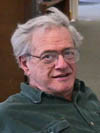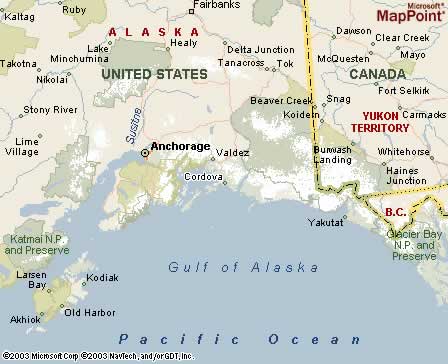|
|
Canku Ota |
|
|
(Many Paths) |
||
|
An Online Newsletter Celebrating Native America |
||
|
July 26, 2003 - Issue 92 |
||
|
|
||
|
Ancient Tongues Fade Away |
||
|
by Dennis O'Brien Sun
Staff
|
||
|
"If you were expecting a little baby, and it went back to its home so that it wasn't born alive, how would you feel?" says Smith, 85, who moved to Anchorage from her tribal home on Prince William Sound in 1973. A fisherman's daughter, Smith grew up with Eyak, a branch of the Athabaskan-Tlingit family of languages spoken for 3,000 years in Cordova, along the Copper River. But she stopped speaking Eyak when she attended government schools. Neither her children nor grandchildren know the language. "I should have made them learn it, but they just weren't interested," she said. Eyak is among thousands of languages expected to disappear in the next 100 years, a mortality rate that has linguists rushing to document and save the world's endangered tongues. "We're losing a part of our cultural history," said Michael Krauss, a University of Alaska linguistics professor and founder of the Alaska Native Language Center, established in the 1970s to save the state's 20 native tongues.
"I'd be the happiest guy in the world if I were wrong," Krauss said. But he noted that only 500 to 600 languages are spoken by at least two generations, making them relatively safe from extinction. According to experts, half the people on the planet use just 15 languages to communicate, while 10 percent of the population speak in one of about 6,800 distinct tongues. Half the world's languages are spoken by fewer than 2,500 people, mostly in remote areas that are becoming less remote every day. Global economics are prompting the young to leave isolated villages in India, Mexico and South America. They're headed for cities in search of better lives, leaving native tongues behind. Meanwhile, satellite TV and the Internet are reaching into isolated areas of Papua New Guinea, a South Pacific island nation with 832 languages, more than any other country. "If you go to Papua New Guinea and go out in the most remote areas you can find and you'll see grass huts, and alongside one of them you'll see a satellite dish, and of course the TV that's coming in is coming in English," said Anthony Aristar, a linguistics professor at Wayne State University in Detroit who studies dying languages. He is creating a $2 million database listing the world's tongues. Words
come, languages go For example, linguists note that the Norman Conquest transformed early English, which has its roots in German. Latin, the language of the Roman Empire, replaced Etruscan and Punic before it diversified and influenced 30 other languages, including English. Sometimes, government policies kill a language. Many Native American languages are near extinction - the Lipon Apache have two or three speakers left - in part because government-run boarding schools punished students for speaking native languages until the 1960s. Krauss says that about half of the 200 languages native to North America will probably die out over the next century because so few children are picking up them up. Alan Caldwell, director of the Culture Center at the College of the Menominee Nation in Wisconsin, remembers his father telling of having his hand slapped with a ruler and his mouth washed out with soap for speaking Menominee at the reservation school, which has closed. The experience left the elder Caldwell, who died in 1972, reluctant to speak the native tongue, or pass it on. "We'd be at the dinner table and we would ask him, 'How do you count to 10? How do you say salt and pepper?' And depending on his mood, most often his response was, 'You don't have a need to know that, it won't do you any good,'" Caldwell said. As a result, only 40 of the tribe's 8,800 members speak the original language. That's one reason why Monica McCauley, a University of Wisconsin researcher, drives three hours to the reservation each week. Macaulay recently won a National Science Foundation grant to compile the first complete Menominee dictionary. The project includes taping the tribe's elders and transcribing conversations to capture the nuances of the language. Tribal elders agree that without such help, the language may disappear. And Caldwell, 55, is in a "beginners" class taught by the elders. In Guatemala, parents encourage their children to forsake native Mayan dialects and learn Spanish to get ahead in life. "They go to school and they see that success depends on learning Spanish," said Nora England, a linguistics professor at the University of Texas. Some
languages saved "Some of them are as different from each other as English is from Russian," England said. Success stories exist. Hebrew, once nearly dead as an everyday spoken language, was redeemed from ancient texts after 2,000 years and is spoken by about 5 million people, mostly in Israel. Hebrew's resurgence was aided by its role in the effort to establish a national identity for Israel after World War I. The fight to save other dying languages is more of an uphill battle. Critics argue that it's a waste of time and money if cultural trends dictate their eventual demise. Neil Seeman, an associate editor at the National Review who operates a Canadian think tank, said that while dying languages should be recorded for historical study, governments are responding to political pressure with a kind of "cultural protectionism" by forcing languages on people who no longer have use for them. "I have nostalgia for the electronic typewriter, but I don't see a need for subsidies to protect it, or continue its use," Seeman said. But linguists say that a society's culture and history die out when its language expires. "Part of the world is lost when you can't name it," said Stephen Batalden, a linguist at Arizona State University. In Alaska, Smith says she hopes for a resurgence in Eyak, now that Krauss has recorded her language on tapes and in writing. "I have this feeling in my heart that the Eyak language is going to come back, and usually I'm not wrong about these feelings," she said. And if it happens she will respond with a one-word prayer: awa'ahdah. That's Eyak for "thank you." |
|
|
www.expedia.com |
|
|
||
|
|
||
| Canku Ota is a free Newsletter celebrating Native America, its traditions and accomplishments . We do not provide subscriber or visitor names to anyone. Some articles presented in Canku Ota may contain copyright material. We have received appropriate permissions for republishing any articles. Material appearing here is distributed without profit or monetary gain to those who have expressed an interest. This is in accordance with Title 17 U.S.C. Section 107. | ||
|
Canku Ota is a copyright © 2000, 2001, 2002, 2003 of Vicki Lockard and Paul Barry. |
||
 |
 |
|
|
The "Canku Ota - A Newsletter Celebrating Native America" web site and its design is the |
||
|
Copyright © 1999, 2000, 2001, 2002, 2003 of Paul C. Barry. |
||
|
All Rights Reserved. |
||
 Marie
Smith knows that her language - the Alaskan tongue of Eyak - will
die with her. And she mourns its passing.
Marie
Smith knows that her language - the Alaskan tongue of Eyak - will
die with her. And she mourns its passing.  Krauss
and other linguists blame the losses on economic and social trends,
politics, improved transportation and the global reach of telecommunications.
Whatever the reason, they predict that up to half of the world's
6,800 tongues could die over the next century - and hundreds more
will disappear in the century after that.
Krauss
and other linguists blame the losses on economic and social trends,
politics, improved transportation and the global reach of telecommunications.
Whatever the reason, they predict that up to half of the world's
6,800 tongues could die over the next century - and hundreds more
will disappear in the century after that.